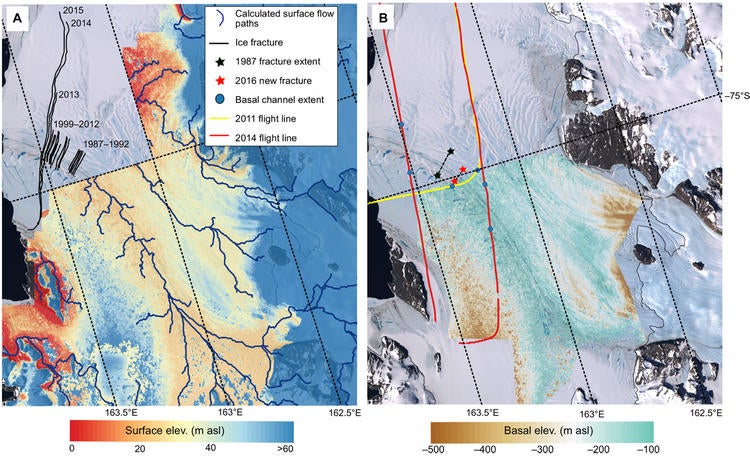Ice shelves control sea-level rise by slowing, through frictional resistance, the seaward flow of grounded glacial ice. Break-up and reduction in size of the ice shelves that currently protect much of Antarctic grounded ice will therefore determine much of our future sea level conditions. Basal channels, carved by currents into the base of the ice shelf where it floats upon the ocean, are known to thin the ice and alter its stress distribution, making the ice shelf more susceptible to basal or surface fractures. Flow-parallel fractures have been observed and attributed to basal channels, but flow- perpendicular fractures, which are important controls on rates of ice shelf calving or breakup, have not been directly related to basal channel formation. Furthermore, surface river channels have not, to-date, been linked to the presence of basal channels.
We present evidence from multiple ice shelves in Antarctica and one in Greenland that demonstrates that basal channels drive the formation of transverse surface fractures. Basal channels in two of these systems also facilitate the formation of a surface river, increasing the susceptibility of the ice shelf to localized thinning and rifting by hydrofracture.
Methodology
Our international team of polar scientists’ main study area was the Nansen Ice Shelf, which is located in the western Ross Sea, East Antarctica. To investigate the characteristics of the Nansen Ice Shelf basal channel and its co-located surface river, we used airborne ice-sounding radar and laser altimeter data collected by the International Collaborative Exploration of the Cryosphere through Aerogeophysical Profiling project in October 2011, and the Geophysical Investigations of Marie Byrd Land Lithospheric Evolution project in December 2014. We developed a Digital Elevation Model (DEM) of the Nansen Ice Shelf surface to investigate the topography over a broader scale than the flight line observations allow. This DEM was constructed by combining radar and laser altimetry data with stereo photometry. We also mapped advection of fractures on the surface of Nansen Ice Shelf using Landsat imagery, the first identified in 1987 and a second identified in 2016 during in situ field data collection. The 1987 fracture eventually resulted in a large calving event in 2016.
Outcomes
The location of both the 1987 Nansen Ice Shelf fracture and the new fracture that was found in November 2016 are over the thinnest region of the basal channel (Fig. 1b). Moreover, the lateral extent of the 1987 fracture is limited to the width of the basal channel (Fig. 1a). These fractures therefore illustrate the weakening impact of the basal channel. To investigate the cause of these transverse fractures, we used ice shelf surface velocity products to calculate the surface strain rate field. All scenes that we analyzed featured bands of cross-flow compression and extension within the basal channel–induced surface depression. We hypothesize that the release of friction due to the expansion and eventual calving (in 2016) of the 1987 fracture allowed flow acceleration, and therefore extensional strain, driving the formation of the new 2016 transverse fracture. This suggests that the longitudinal fracture location is controlled by the wider strain regime of the ice shelf, while its transverse location is fixed by the location of the basal channel.
We observed a similar basal channel-induced fracturing pattern on other ice shelves, including Totten Glacier Ice Shelf, Moscow University Ice Shelf, Pine Island Glacier, Abbot Ice Shelf in the Antarctica and Petermann Glacier in Greenland.

FIGURE 1: Nansen ice surface and bed DEMs.
The formation of transverse fractures over thin ice caused by basal channels appears to be a phenomenon observed across ice shelves with variable characteristics, including highly sensitive systems. Many of these systems with basal channels do not yet have surface rivers associated with them, suggesting that the thinning by the basal channel plays the primary role for fracturing. However, the addition of a surface river on ice thinned by basal channels could cause further weakening by surface incision and hydrofracturing when flowing into basal channel-driven fractures. It has been suggested that surface rivers may stabilize ice shelves by removing water that might otherwise collect into melt ponds. However, we demonstrate that the Nansen surface rivers only remove water from the region of the ice shelf where the basal channel causes a surface depression. The river can then enhance ice shelf surface erosion in the thinnest ice overlying a basal channel and will direct water into transverse surface fractures more rapidly than would be possible for water separated into multiple melt pond drainage basins. If the surface rivers do not cause weakening of an ice shelf by incision or hydrofracture, at the very least they, through hydrostatic balance with basal channels, are indicators of their presence, which, as we have demonstrated, are locations of potential weakness in ice shelves.
Conclusions
This study underscores that the warming effects of climate change are impacting our planet in ways that are often more dangerous than we perhaps had thought. There are many vulnerable ice shelves in the Antarctic that, if they break up, will accelerate the processes of sea level rise. As warmer salt water erodes channels into the ice that holds the glaciers on stable land, it also generates massive vertical fractures that split glaciers from above and below. Surface water melting on top of the ice shelves then pours into these cracks, accelerating the problem further. This process will likely become more prevalent with increased access of warm ocean water to ice shelves, exacerbating basal channel melting and warming air temperatures enhancing surface water formation.
Dow, C.F., Lee, W.S., Greenbaum, J.S., Greene, C.A., Blankenship, D.D., Poinar, K., Forrest, A.L., Young, D.A., & Zappa, C.J. (2018). Basal channels drive active surface hydrology and transverse ice shelf fracture. Science Advances. 4(6), 7212.
Contact: Christine Dow, Department of Geography and Environmental Management
For more information about WaterResearch, contact Amy Geddes.







